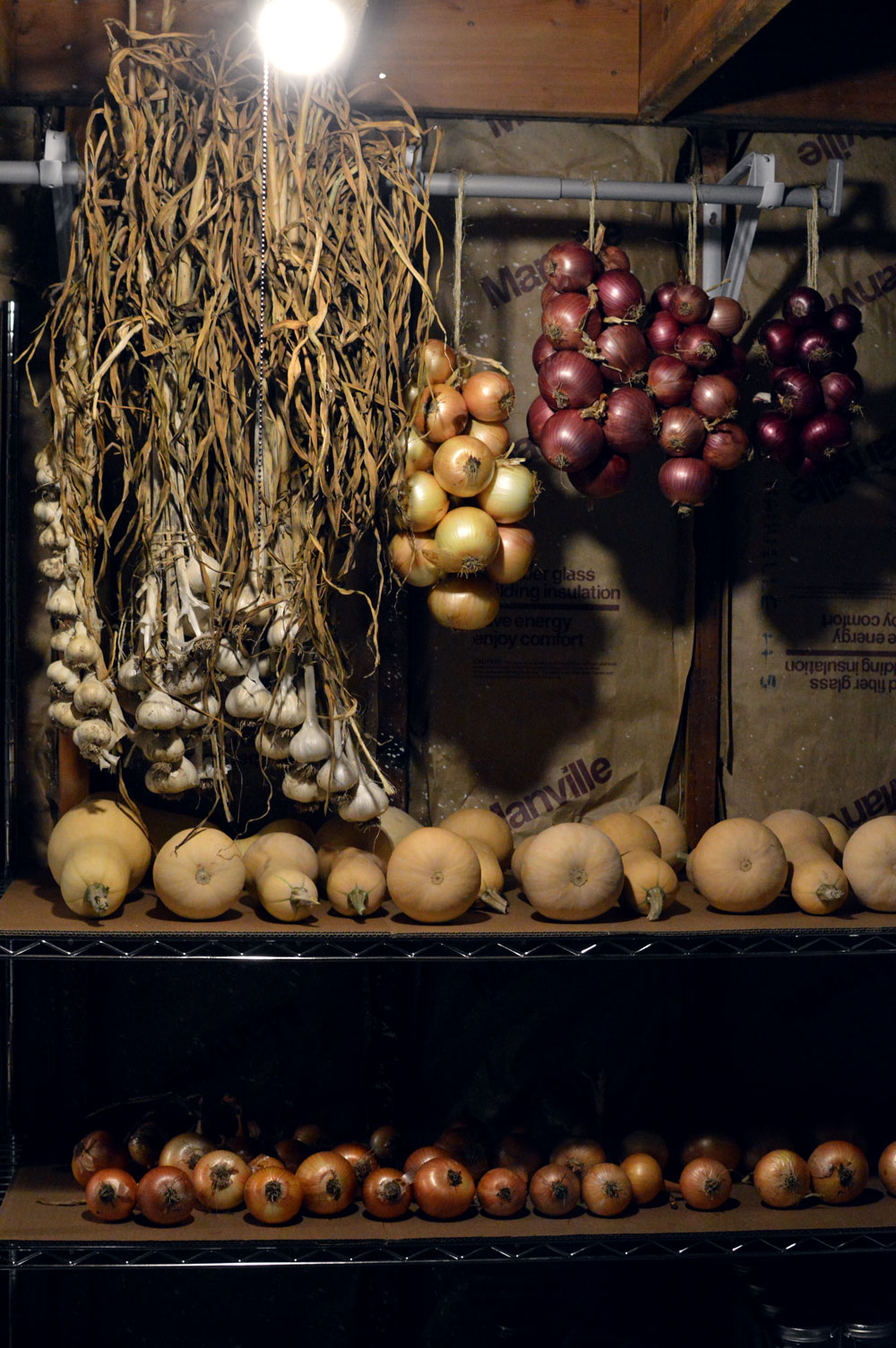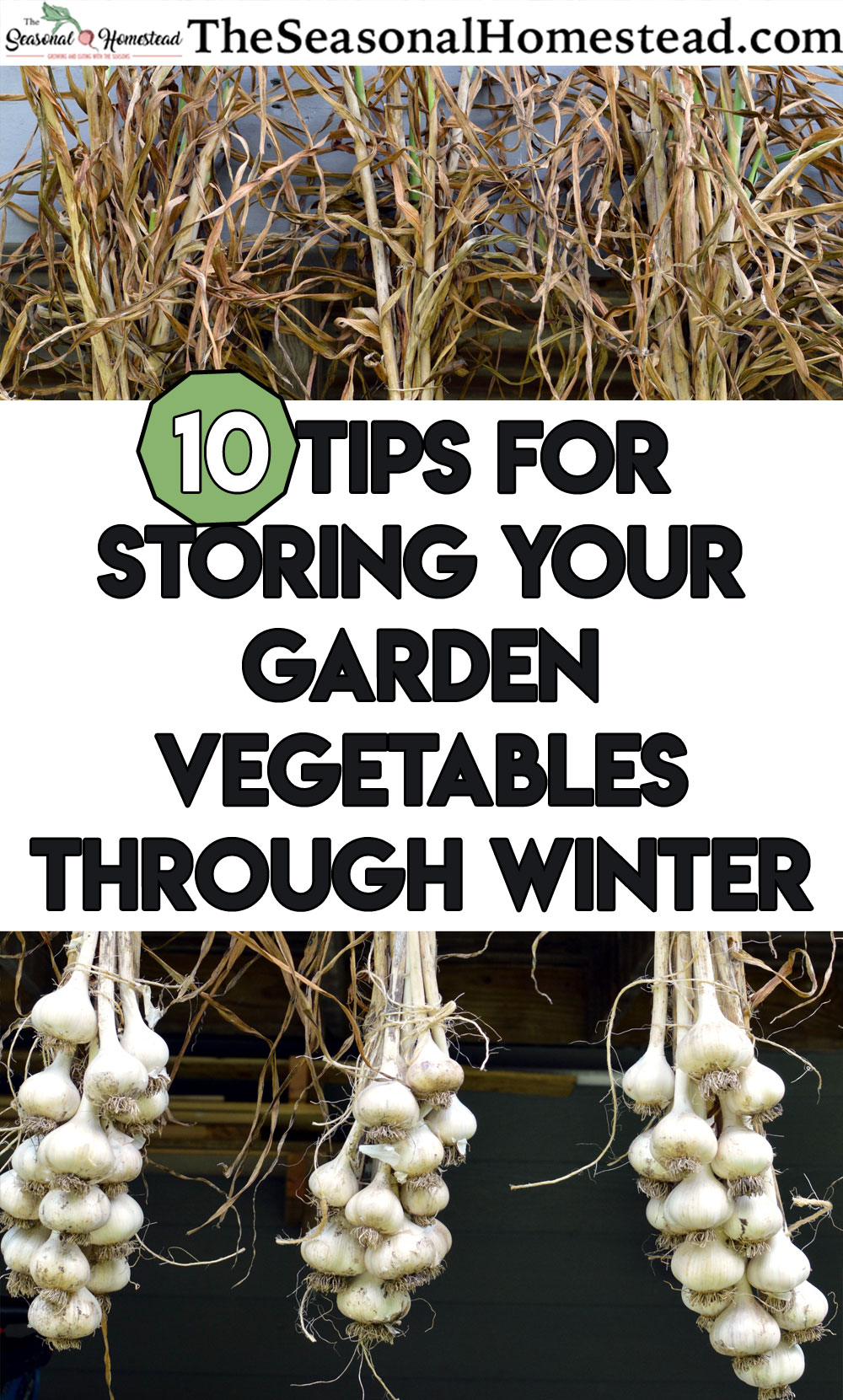This post contains affiliate links. Full disclosure can be found here.

#1 Provide the proper temperature
This should be a high priority when keeping vegetables. As it makes such a difference in the long keeping and storing ability.
 Chart Courtesy of Maine Organic Farmers and gardeners association. Full PDF HERE .
Chart Courtesy of Maine Organic Farmers and gardeners association. Full PDF HERE .
Refer to the chart above for proper temperatures of storing vegetables.
I personally find the 50-60 temperature easy to achieve in my unheated basement. The difficulty comes in when you need temperatures around 40 degrees. If it’s a small amount of produce, I will store that in my refrigerator. I’ve had cabbages last for over 5 months when kept in the refrigerator.
My mother in law in chilly Idaho (she is in zone 4!), stores onions, potatoes, and winter squash in her garage over the winter with success. She keeps them covered with blankets so they don’t freeze, and close to the house door and wall. Having them close to the door helps her remember to use them up and I imagine it also added a little buffer against the cold.
Other options include partitioning off part of the basement to make an area cool enough. And then of course, if you have a really good root cellar that keeps cold, that is ideal.
#2 Cure vegetables that require it before storage.

This includes potatoes, garlic, onions, sweet potatoes, and winter squash. Curing toughens up the skin to allow for long storage.
-
Onions need 3-5 days to sun cure after roots have been pulled.
-
Potatoes should be cured in a dark, humid, well ventilated area for 10 days.
-
Sweet potatoes need high humidity and warm temperatures to cure. Keep them out of direct sunlight.
-
Garlic is often cured in the sun for a week but I personally find mine does better on a shaded patio where it gets morning sun and afternoon shade.
-
Winter Squash is best cured in the sunlight 2 weeks.
#3 Keep storage room ventilated
While not all of us have a root cellar (I don’t), we can make the most of the storage spaces we have. Ventilation is very important if you want to prolong the life of your vegetables.
In the ideal root cellar set up, you would have a cold air intake vent at the base of the root cellar wall and on an opposite wall and the top would be the warm air outtake vent. Cross ventilation is best.
In my basement, I don’t have either of those things, but it is unheated, and it’s not closed off tight from the rest of the house so it does get some ventilation, though not the ideal kind.
I also keep a fan on during the day until temperatures drop in the Autumn because instead of the usual 50 degrees (fahrenheit) it maintains in the winter, in the summer it hovers around 65-70 degrees.
#4 Cut off leafy tops
If you leave on leafy tops, it will suck the moisture from the roots which are connected. Carrots, radishes, turnips, etc, will all start to shrivel up and lose their quality with the roots attached.
Cutting off the tops should be done immediately after digging before you store the vegetables away.
#5 Don’t wash your vegetables before storing

A little bit of soil stuck to those root vegetables is perfectly ok! In fact it is better not to scrub your veggies before they get stored.
If you have big dirt clots stuck to the roots, give them a chance to dry and then knock off any excess soil.
#6 Provide the right humidity
Some vegetables need high humidity and some need low. It’s important to know which requires which so you can try and meet their needs. A simple humidity and temperature thermometer can help you monitor the conditions in your cold storage area.
In a root cellar situation, high humidity is easily achieved by having a dirt floor in the underground cellar. If you don’t have a dirt or gravel floor, other means of storage can be used to add the needed humidity.
You can pack vegetables like carrots, beets, and parsnips in damp sawdust or sand. (Don’t do this if your area is above 40 degrees as it can cause mold problems)
You can set pans of water on the floor to evaporate and humidify the air.
Or spread damp (not soaking) burlap bags over the produce.
#7 Don’t keep bruised or insect eaten produce
Harvest your produce carefully to avoid bruising it. Keep only the best produce you harvest for cold storage. If it’s bruised or bug eaten it won’t keep as well so make sure to eat those first.
#8 Keep vegetables off a concrete floor
Having produce resting on the floor can encourage mildew formation. It’s best to keep it raised in baskets or on shelves.
#9 Keep it dark

Exposure to light reduces the life of many storage vegetables. While you probably already know potatoes like it dark, did you know that other vegetables will last longer in the dark than if left in the light?
You can read more of the science of why this is true in THIS ARTICLE. Here’s a good excerpt: “Scientists have shown that fresh or near fresh [supermarket] vegetables”do not usually exceed the two weeks’ useful shelf life”, and that light promotes their deterioration since this accelerates the transpiration and respiration of these plants, and changes the way they behave.”
#10 Remove Spoiled Produce Quickly
Spoiled vegetables and fruits are a normal part of storing food over winter. However, it should only be a few here or there. If a large portion of your food is spoiling you need to figure out why.
When you do experience a sprouting onion or squishy squash, remove it immediately. Your nose is a great indicator of spoilage. This is often how I notice a vegetable has started to decay in my own cold storage room.
The old saying one bad apple can spoil the whole barrel is actually true. Ripe fruit emits more ethylene gas signally other fruit around it to ripen quickly as well. The same is true with mold. Mold from one spoiled food will send out spores to other old food and make the go rancid more quickly.
Further Reading:
http://chemung.cce.cornell.edu/resources/storage-guidelines-for-fruits-vegetables.pdf
http://www.mofga.org/Portals/2/Fact%20Sheets/FS%2015%20Storing%20Garden%20Veg.pdf
https://www.canr.msu.edu/resources/home_storage_of_fruits_and_vegetables_e1696
If you want a very comprehensive book on Root Cellaring, I highly recommend the one below. It’s where I obtained most of my knowledge on the subject. Just click below!

Want to learn about the best varieties to store? Check out this post…
-
30+ Best Storage Vegetables and Varieties for Winter Cold Storage
In the year round garden, when the going gets tough (freezing temps, winter storms, you name it!), you need to have a backup source of food, and more specifically, fresh food. Even with vegetables that can extend your season (mentioned HERE) and low tunnels, once you hit very cold temperatures there isn’t much left in the garden. January through March is when I really struggle to do 100% backyard garden vegetables because of prolonged periods of cold, ice, and snow. I’m in zone 6b so if you are in a colder zone this period is probably longer.
by Becky Porter

